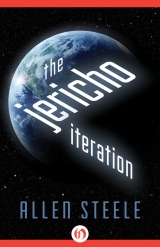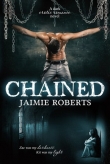
Текст книги "Jericho Iteration"
Автор книги: Allen Steele
Жанр:
Боевая фантастика
сообщить о нарушении
Текущая страница: 16 (всего у книги 20 страниц)
PART FOUR
His Court of Love and Beauty (April 20, 2013)
19
(Saturday, 2:00 A.M.)
Beep-beep …
Beep-beep …
Beep-beep …
I awoke to a steady electronic pulse from somewhere in the darkness.
My first thought was that it was the phone on my desk. Then I remembered that I was not in my apartment but instead hiding out in an abandoned house on the south side.
It had taken me the better part of the afternoon to make my getaway from Clayton. I rode the Yellow Line as far south as I could, then got off the MetroLink at the Gravois Avenue station and hiked as far as I dared into this dangerous part of the city. The police seldom ventured this far south except in Russian APCs, and even ERA troopers were reluctant to patrol the edges of Dogtown save by helicopter; perhaps the dragnet wouldn’t extend into this combat-zone neighborhood not far from the Mississippi River.
I hadn’t encountered any heat either on the train or on foot during my long journey through the city, but I was exhausted by the time I had found the house. Even after my close brush with the ERA Apache earlier tonight, I had soon fallen back asleep on the couch, trusting the stray dog who had adopted me to wake me up again if the chopper returned. The mutt had curled up on the floor next to the couch; he raised his head now, his brown ears cocked forward in curiosity as he stared at the source of the noise.
Joker lay on the bare floor where I had left it after I had finished dictating my notes, its red LED flashing in time with the annunciator. The dog got up and padded across the empty living room to sniff at it, then he looked up at me: Well, what are you going to do about it?
Someone-or perhaps something-was trying to get my attention.
“I dunno what it is either, buddy,” I murmured. “Let me see what’s going on.”
Drawn by the blinking diode, I swung my stiff legs off the couch and shuffled across the room to where the FT lay. Kneeling on the hardwood floor, I picked up Joker and opened its cover, expecting to find another mysterious IM displayed on its screen.
What I saw instead was a ghost: the face of my dead son, stolen from the video I had made of him a little over a year ago, now outlined in tiny animated pixels. Across the bottom of the screen was a message bar.
›Gerry Rosen, I need to talk to you.‹
›Daddy, I need to talk to you.‹
›Please talk to me, Gerry.‹
“No!” I yelled. “Leave me alone!”
I raised the PT over my head, about to hurl it across the room. Frightened by my surge of anger, the dog danced backward, whining a little as its tail crept down between its hindquarters. If nothing else, the dog’s reaction helped check my impulse; instead of dashing Joker against the wall, I lowered the PT and stabbed its vox button with my forefinger.
“Listen, you shit,” I snarled, “you’ve done enough to me already! Leave Jamie out of this!”
Jamie’s face didn’t vanish from the screen. Instead, the image blinked at me, somehow managing to assay a childish pout. God, it was scary; computer generated or not, it looked exactly like my kid.
Jamie’s voice emerged from Joker’s speaker. “I’m sorry, but I’m trying to get your attention in the best way I can. Does this form and voice displease you?”
“God, yes!” I yelled at the screen. “Don’t you understand? This is my son you’re using! He’s dead! Don’t you realize what this does to me?”
Jamie’s face assumed a confused expression. “Jamie Arnold Rosen,”it intoned; it was as if Jamie himself were reciting his life history, except in words, that a six-year-old would never have used. “Born March 2, 2006. Died May 17, 2012.Killed during the New Madrid earthquake while riding the MetroLink train across the William Eads Bridge. The Eads Bridge collapsed, resulting in the deaths of seventy-three passengers including twelve members of the first-grade class of Bo Hillman Elementary School, who were returning from a field trip to-”
“You think I don’t know that already?” I sagged to the floor, clutching Joker in my hands. “Why are you telling me this?”
“The circumstances of your son’s death are a matter of public record. I was in doubt whether you were suffering from undiagnosed survivor’s syndrome and therefore amnesiac about-”
“No, I’m not suffering from survivor’s syndrome, and I didn’t forget.” I took a deep breath and closed my eyes. “And lemme tell you something that isn’t a matter of public record … Jamie was on the train because I didn’t want to drive over to Illinois and pick him up after he went to see the steel mill. I was busy trying to write a book, so I bought him a train ticket instead, and if I hadn’t done that he might still be alive.”
“There’s a strong probability that this is a correct assumption.”
“You’re goddamn right it’s a strong probability!” I snapped, my anger surging out of me. “So get him off the screen, you son of a bitch, and stop torturing me!”
Jamie evaporated from the screen; pixel by pixel, starting from the top of his head and moving downward past his brow, eyes, nose, mouth, and chin, my son’s features disappeared, leaving behind an androgynous, stylized face devoid of any distinguishing characteristics.
“Is this image more comfortable to you?”a sterile adult male voice inquired. The face’s mouth moved when it spoke, but otherwise it displayed no emotions.
I took a deep breath, letting it out as a soft, shuddering rattle. “Yes, it is,” I said, “but can we switch to readout instead? It would … it would be easier on me if you did.”
The face remained, but the dialogue bar reappeared at the bottom of the screen: ›Are you more comfortable this way?‹
“Yeah, thanks.” I thought about it for a moment. “Why did you take Jamie’s face in the first place?”
›When I attempted to contact you earlier [Wednesday, April 17, 7:59 P.M.] I used the e-mail function in this node [i.e. Joker]. That attempt confused you, resulting in miscommunication between you and Beryl Hinckley. I was therefore forced to appropriate a medium that could not be confused with either a living person or a computer-simulated persona. I searched all available records and found your son. Do you understand now?‹
“More or less, yeah.” I propped my back against the wall, crossing my legs before me and placing Joker on my ankles. The dog yawned and lay down on its belly nearby. “So … is this Joker I’m talking to, or Ruby Fulcrum?”
›Joker is a node of the intelligent a-life-form you know as Ruby Fulcrum. All the functions that Joker is capable of performing, I can perform as well. Clarification: you are speaking to both Joker and Ruby Fulcrum. Do you understand?‹
It dawned on me that this was a little like asking a cell at the tip of my left pinkie whether its name was Bart or Gerry Rosen. Remember how it was when you were a kid and you first came to grips with the notion that the universe was infinite, that outer space just kept going and going and going, star after star, galaxy after galaxy, a deep and everlasting black vastness stretching forever, until using terms like light-years and parsecs became as meaningless as trying to describe the breadth of the continents or the depth of the oceans in values like millimeters or inches? The idea was so staggering that your mind automatically pushed it aside: such enormity is nearly impossible to contemplate on the human scale, and trying to do so without the abstractions of higher mathematics is an invitation to madness.
This was Ruby Fulcrum. The phase transition Hinckley had told me about had been achieved. I was no longer talking to Joker but instead to a tiny fraction of a vast cybernetic entity spread across hundreds of thousands of machines, from little Toshiba palmtops to Apple desktop terminals to IBM office mainframes to great Cray supercomputers, all interfaced by a digital/neural-net hybrid architecture as intricate as the hundreds of miles of veins and capillaries in a single human body.
Say howdy to God, Gerry Rosen. Or someone just like Him.
“Yeah,” I said. “Sure, I guess so.” I self-consciously coughed into my hand, feeling my arms and legs beginning to tremble. “So … umm … what do you want with me?”
Ruby’s asexual face stared at me from the screen.
›I need your help.‹
Ruby began to tell me about itself.
Much of what it told me I had already heard before, from Beryl Hinckley, Cale McLaughlin, even John before he had been killed. I didn’t know whether an a-life-form could lie, but if it couldn’t, then Ruby’s side of the story confirmed the facts that had already been revealed to me. Nonetheless, there were many things I hadn’t known before.
After it had been accidentally released into cyberspace, Ruby Fulcrum had spread quickly through the electronic environment, commencing with the other mainframes at the Tiptree Corporation. Nothing could prevent it from accessing even the most secret files at the company: security lockouts were disengaged, passwords were nullified, retinal scans and handprint detectors were bypassed. Within a few minutes, every bit of classified information stored in the company’s computers had been accessed by Ruby, and although Ruby wasn’t yet sophisticated enough to comprehend all that it had learned, it was nonetheless capable of reaccessing all that information on demand.
When the Ruby Fulcrum research team had discovered what had happened during their absence, Richard Payson-Smith had immediately attempted to regain control of the a-life-form, but the genie had already escaped from the bottle, and there was no way it was going to return to confinement. Once Payson-Smith realized that this was the case, he settled for communication; along with Hinckley and Morgan, they began the painstaking process of trying to make direct contact with Ruby. They had created Ruby; now they had to learn how to talk to it, since it had already evolved past the relatively simple LISP computer language they had used to devise Ruby in the first place.
At this point, no one else at Tiptree was aware of Ruby’s true nature, let alone the fact that an a-life-form had escaped from the top secret cybernetics lab. All Cale McLaughlin and everyone else at Tiptree knew was that Payson-Smith’s team had been developing a spin-off from the Sentinel program. The four scientists decided to keep Ruby’s escape a closely guarded secret, at least for the time being. Unlike relatively simple viruses of the past, such as the fabled Internet worm that had spread through the entire network in only a matter of hours, Ruby’s architecture was far more complex; as a memory-resident program, it took longer to propagate itself into other systems.
It was also thousands of times more difficult to pinpoint than the usual garden-variety worm or virus. On the other hand, there weren’t any overt signs of a supervirus running amok in cyberspace: no inexplicable freeze-ups or crashes, no widespread loss of information, no reports from university or government users of a virus loose in the national datanet. Ruby hid itself very well. Believing that time was still on their side, the Ruby Fulcrum team heaved a deep collective sigh; whatever else might have happened, their monster appeared to be minding its manners. There was no sense in panicking Tiptree’s management until they had things under control again, so they kept the problem to themselves.
After several months, Hinckley and Morgan finally managed to develop a means of directly communicating with their prodigal offspring. By the time they achieved this, though, Ruby had already propagated itself through every on-line computer in the 314 area code, and the theoretical phase transition from mere amoeba-like data absorption and replication to true sentience had already commenced. Shortly after Payson-Smith was able to speak directly to Ruby, the iterations necessary to complete this transition had already been accomplished: Ruby was alive, aware, and intelligent.
And it was ready to spill its chips about everything it had learned.
Ruby’s face disappeared from Joker’s screen; it was replaced by a schematic diagram of a spacecraft. ›This is Sentinel 1.‹
“Yeah,” I said. “I know what it is.”
The ABM satellite rotated on its three-dimensional axis. ›38 hours/ 29 minutes/ 42 seconds ago its final components were launched into orbit aboard the NASA space shuttle Endeavour.‹
I tapped Joker’sPAUSE key and the readout stopped; not a bad way of telling a long-winded a-life-form when to shut up. “I know,” I said. “I was at Tiptree for the launch.”
The diagram was replaced by a digitized replay of a TV news clip: two spacewalking astronauts in the shuttle cargo bay, working with the spacecraft’s extended Canadarm as they joined the module with the rest of the giant satellite.
›Yesterday morning [Friday, April 19, 8:27 A.M. CST] the final assembly of Sentinel 1was completed in Earth orbit [altitude 246 nautical miles]. At 5:25 P.M. CST, final checkout of the satellite was completed by the Endeavourcrew. The shuttle maneuvered away from the satellite [9:37 P.M. CST]. Earlier this morning [Saturday, April 20, 12:06 A.M. CST] ground-based telemetry of Sentinel 1was switched from NASA/JSC [Johnson Space Center, Houston, Texas] to USAF/CSOC [Consolidated Space Operations Command, Colorado Springs, Colorado].‹
“Yeah, right. Sure.” I was getting a little tired of all this; it was early in the morning and my eyes were beginning to itch. I could use another few hours on the couch, flea-infested or not. “Just cut to the chase, willya?”
›The primary mission of Sentinel 1is not antiballistic missile defense. Sentinel 1’sprincipal objective is to control the civilian population of the United States of America.‹
I stopped rubbing my eyes. “Whu … what!”
A new image appeared on Joker’s screen: an animated image of Sentinelin orbit above Earth, rotating on its axis until it was pointed straight at a stylized representation of North America. A thin red beam erupted from its long barrel; the animation followed the beam as it raced across space and lanced through Earth’s atmosphere.
›The classified objective of Sentinel 1is to prevent or contain domestic civil uprisings. Its fluorine-deuterium laser is capable of penetrating Earth’s atmosphere and inflicting severe damage upon either airborne or mobile ground units. It can track and target objects within two meters in size. Its low-orbit trajectory will place it above the United States eight times each day, or approximately once every three‹
“Whoa, shut up,” I snapped, hitting the PAUSE key again. “Wait a minute.” I forgot all about catching a few winks on the couch; I sat up a little straighter and held Joker closer to my face. “This thing … I mean, you said … I mean, this sucker’s supposed to be pointed at us?”
The animation was frozen as a window opened on the screen; it expanded to show typewritten pages that scrolled upward faster than my eyes could follow.
›The objective of Sentinel 1was discovered by the Ruby Fulcrum team after they established contact with me and accessed my primary batch-processing subsystem. This information was contained in classified [i.e. Top Secret] memos and documents between Cale McLaughlin, Chief Executive Officer of the Tiptree Corporation, and key civilian and/or military officials of the U.S. Department of Defense and/or various civilian agencies, including the chairman of the federal Emergency Relief Agency.‹
The documents vanished from the screen, to be replaced by a flowchart. Dozens of names were connected to one other by dotted lines.
›These documents indicate the existence of a military-industrial conspiracy operating on the fringes of the American government. The conspirators intend to subvert the elected government of the United States, with the final objective being the installation of a nonelected shadow governments‹
“Who’s behind this?” I asked.
A square was formed around a large block of names, then the square zoomed to the forefront of the diagram. ›The principal force behind this planned coup d’etat is the Emergency Relief Agency.‹
“Goddamn,” I whispered. “But why ERA?”
›At this point, it is unknown exactly how the conspirators intend to overthrow the present government. However, classified memoranda between ERA officials indicate a strong probability [86.7 %] that the first step in the coup d’etat will be the incitement of armed hostilities between the United States and the new government of Cascadia.‹
The diagrams disappeared; they were replaced by a map of the Pacific Northwest, with the new borders of Cascadia traced in blue above the Washington and Oregon state lines. Tiny red markers were placed just within the borders.
›When this occurs, Sentinel 1will be used to neutralize strategic forces belonging to the Cascadian militia. At this time, ERA forces will be deployed to major American cities. The stated intent will be to prevent uprisings from civilians sympathetic to the Cascadian cause. Various state and municipal officials who are aligned with the conspiracy will demand that martial law be imposed in their localities to preserve public order.‹
“Like here in St. Louis …” I began.
A map of the city appeared on the screen. ›Affirmative. Because of the New Madrid earthquake, St. Louis was the first city to be placed under paramilitary control by ERA. The conspirators consider St. Louis to have been a successful test of their ability to control a large civil population. Two principal members of the conspiracy have already taken measures to assert political control of the local government.‹
The pictures of two men appeared on the screen. I stared at them, realizing that it all made sense, yet still not quite believing what I was seeing.
“I’ll be goddamned,” I whispered.
The photos were of Steve Estes and George Barris.
As much as I needed a breather, Ruby didn’t give me time to contemplate all that it had already divulged to me. The photos of Estes and Barris were promptly replaced by photos of the Ruby Fulcrum team.
›Dr. Payson-Smith, Dr. Hinckley, Dr. Morgan, and Dr. Kim became aware of these facts when they accessed my memory. They decided to denounce the conspiracy, with the first step to be their public disclosure of the secret agenda behind Sentinel 1.This would have necessitated publicly acknowledging my own existence, which they considered to be as important as the facts behind Sentinel 1itself.‹
“And this was why my paper was contacted,” I said.
John’s face was added to the screen. ›As the first step, affirmative. Because they believed it was important that the local press be made aware of ERA’s true mission in St. Louis, they contacted John Tiernan, senior reporter for the Big Muddy Inquirer.However, they were unaware that their workplace was under electronic surveillance by their employer. This, in turn, led to counterintelligence operations by federal operatives.‹
“You mean ERA,” I said.
›There is a strong probability [79.2 %] that ERA was involved in the covert operation.‹
“So Barris decided to rub ’em out.”
›Yes. Kim Po and Beryl Hinckley were liquidated by a government-trained assassin employed by ERA. A portable laser rifle was chosen as the instrument of assassination in order to frame Dr. Payson-Smith with the murders.‹
Po’s and Hinckley’s pictures disappeared from the screen. ›As part of the coverup, John Tiernan was also killed in order to prevent him from disclosing this information.‹
John’s face vanished, to be replaced by my own. I had joined Payson-Smith and Jeff Morgan on this unholy shit list.
›You are now wanted by federal authorities on formal charges of treason with intent to cause civil insurrection. ERA forces have been told that you and the others are considered to be armed and dangerous. They have been instructed to use lethal force if you do not surrender yourselves on first warning.‹
I took a long, deep breath as I stared at the screen. All at once the scattered pieces of the puzzle were beginning to come together. The subtle relationship between the Tiptree Corporation and Steve Estes, the alliance of Barris and McLaughlin, the continued presence of ERA troopers in St. Louis eleven months after the New Madrid earthquake, the murders of three people-all were part of a deadly mosaic that only a freak accident, the release of the a-life-form called Ruby Fulcrum, had exposed.
“I don’t understand,” I said. “You said you wanted me to help you. What do I have to do with all this?”
›You do not understand this? Do you wish me to reiterate?‹
I rubbed at my eyelids. “No, no, don’t do that,” I said. “I just … I dunno. I’m just a bystander, y’know? I’m stuck in the middle, that’s all.”
›Dr. Payson-Smith and Dr. Morgan will explain this further when you meet them.‹
A city map appeared on the screen; a small red circle was traced over a tiny green spot on the map, then the circle expanded as the computer zoomed in.
›Do you recognize this location?‹
I peered closer at the screen. The red circle surrounded the Compton Hill Reservoir, a small municipal park not far from downtown. It was located a couple of miles from my hideout. “Sure, I know it. Are they holed up there?”
›Yes. You will proceed to the reservoir water tower immediately. Dr. Payson-Smith and Dr. Morgan are expecting your arrival within the next thirty minutes.‹
“What?” I shook my head, almost laughing out loud. “Hey, wait a minute …”
›Waiting.‹
“I don’t know if you know this,” I went on, “but I’m in one of the worst areas of the city right now. If I try hiking over there, I’m probably going to get a knife stuck between my ribs.”
The map was replaced by Ruby’s genderless face. ›I am aware of your location and of the hazards of traveling on foot. While we have been discussing the situation, I have arranged for safe transportation to the reservoir.‹
At that instant, there came the short bleat of a car horn from outside the house.
I jerked, almost dropping Joker to the floor; the stray dog awoke from its slumber and, leaping to its feet, ran to the window, growling and barking loudly at something out in the darkness.
›That is all for now. We will speak again soon.‹
Then the screen went blank.
I waited for another moment, half expecting the toneless voice to return. When it didn’t, I folded up Joker and shoved it into my jacket pocket, then got up off the floor and tiptoed cautiously to the window. The dog was barking at a car that had pulled into the driveway; its headlights were out, but I vaguely recognized its shape from the amber brake lights.
“It’s okay, boy,” I murmured, giving the dog a scratch behind the ears as the car horn sounded again. “C’mon, it’s time to go …”
I opened the front door and let the dog out; he followed me across the tiny front lawn to the end of the driveway where a black ’92 Corvette was parked, its V-8 engine idling. The passenger window slid down as I approached, and there was the soft click of a gun’s hammer being pulled back.
“Chevy?” I called softly, freezing in midstep. “Chevy, is that you, dude?”
The dome light came on, revealing one of Chevy Dick’s garage buddies riding shotgun in the front passenger seat. The Glock automatic in his hand was pointed straight at me. “That him?” he asked the driver, never taking his eyes off me.
“Yeah, that’s him,” Chevy Dick replied. “C’mon, Gerry, get in already! It’s fucking dangerous ’round here! Jeez!”
I looked down at the dog; he was squatting on his haunches, his tongue lolling out of his mouth. The tongue disappeared as the mutt frowned, catching the expression on my face: hey, Ger, don’t leave me here …
“Can I bring the dog?” I asked.
“Aw, man, he’ll just tear up the upholstery-”
“No, he won’t,” I said. “He’s cool.”
“I’ve got genuine leather in here. He’ll drool all over it-”
“C’mon, Chevy … he saved my life. Honest.”
Chevy Dick looked away and muttered under his breath, then he reluctantly nodded his head. “Okay, okay,” he muttered. “But if he shits back there, you gotta clean it up, awright?”
I nodded. The Latino kid opened the door and stepped out of the car, pulling forward the back of his seat to let the dog and me scramble into the cramped rear compartment. As his buddy climbed back in and slammed the door shut, Chevy switched off the dome lamp, then pulled a can of Budweiser out from under his seat and tossed it back to me.
“Hey, it’s good to see ya, man,” he said as he backed out of the driveway, “but you picked a fuck of a time to call me.”
“I’m sorry,” I murmured, tucking the beer into my jacket pocket. The dog curled up next to me, placed his head in my lap, and licked the back of my hand. I ran my hands along the fur at the nape of his neck. “I didn’t mean to …”
I stopped as I realized what Chevy Dick had just said. “What do you mean, I called you?”
The two men in the front seats glanced at each other in confusion. The kid in the passenger seat muttered something in Spanish, and Chevy Dick responded with a laugh; then he put the car in gear. “Hey, man,” he said as the Corvette rumbled down the narrow street, its headlights still extinguished. “Maybe you don’t remember, but you called me. Begged me to come out here and pick you up right here.”
“I did …?”
“I saw your face, heard your voice.” Chevy Dick shrugged and looked back at me again. “Listen, I don’t mind doing a favor for an amigo, but if you can’t remember, I’d just as soon-”
“No,” I said hurriedly. “That’s great … I just forgot, that’s all. Get me out of here.”
Ricardo and his fellow motorhead glanced at each other again; there was another exchange of Spanish jokes at my expense, then Chevy hit the headlights.
“Hang on to your dog, buddy,” he said. “We’ve got a rough ride ahead.”
Then he popped the clutch, and the Corvette hurtled down the street, its engine roaring as the massive machine pitched itself into the night.








